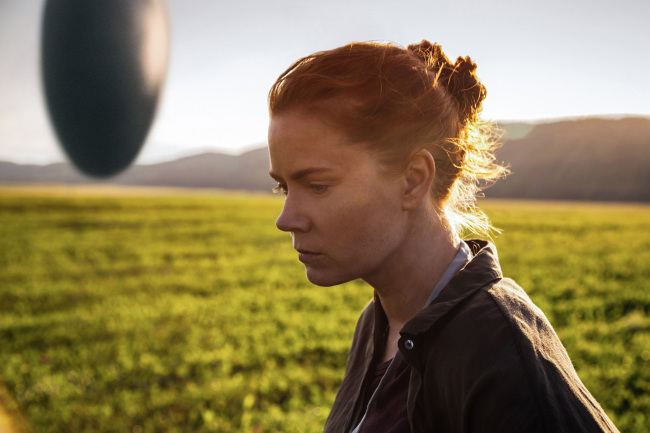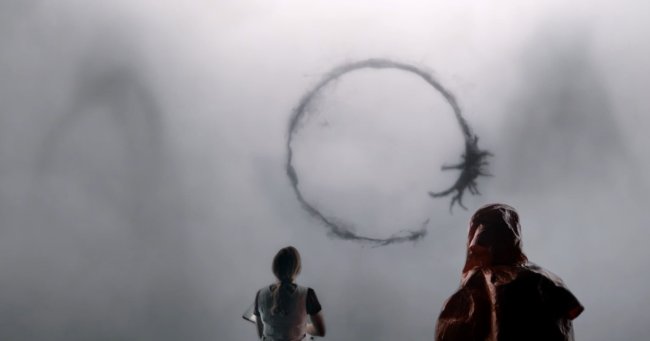'Arrival' is Amy Adams' close encounter with aliens and conflict
By Rumy DooPublished : Nov. 11, 2016 - 13:14
The alien spacecraft in “Arrival” arrive by the dozen, each of the looming, egg-sliced-in-half-shaped wonders looking like the latest in KitchenAid gadgetry. All around the globe, their contents a mystery to paranoid earthlings, the visitors hover just above the planet’s surface. Why have they come? Do they come in peace? Will the US military and other nations’ leaders give peace a chance?
True to the spacecraft, director Denis Villeneuve is one sleek craftsman. Every subtle camera crawl, each darkness-shrouded visual composition in “Arrival” conspires to unsettle us and hold us in a state of dread or wonder, without being cheap about it. A French Canadian by birth whose best film remains (for now) “Incendies,” a complex mystery based on a stage play, Villeneuve is coming off a couple of well-made pulp outings: the child abduction revenge thriller “Prisoners” (gripping for an hour, then dragged down by its own worst impulses) and the drug cartel maze “Sicario,” similarly strong for much of its running time before settling for the usual.
True to the spacecraft, director Denis Villeneuve is one sleek craftsman. Every subtle camera crawl, each darkness-shrouded visual composition in “Arrival” conspires to unsettle us and hold us in a state of dread or wonder, without being cheap about it. A French Canadian by birth whose best film remains (for now) “Incendies,” a complex mystery based on a stage play, Villeneuve is coming off a couple of well-made pulp outings: the child abduction revenge thriller “Prisoners” (gripping for an hour, then dragged down by its own worst impulses) and the drug cartel maze “Sicario,” similarly strong for much of its running time before settling for the usual.

“Arrival” has little of the usual. It may frustrate or confuse viewers who prefer their humanist science fiction on the order of “The Martian.” Screenwriter Eric Heisserer adapted Ted Chiang’s “Story of Your Life,” a few non-spoiler-y details of which can be relayed. At the start, we hear Amy Adams (terrific, her technique clean and exact) in voice-over, speaking to the girl we see, with her on screen. They’re mother and daughter, together over the years. But too young the girl dies, leaving the Adams character, Louise, alone and the girl’s father out of the picture.
Louise is a linguistics professor and translation whiz, and “Arrival” sets up its increasingly tricky narrative beautifully. The halved-egg alien saucers arrive; the world freaks out; the US military, personified by gently intense Forest Whitaker, shows up at her office door out of nowhere, sussing out Louise’s interest in learning how to crack the (literally) otherworldly beeps and pops and guttural somethings emitted by the inhabitants of the spacecraft. Jeremy Renner plays Louise’s partner in research, a physicist compelled more by science than language. They’re helicoptered to where one of the spacecraft hovers, motionless, just above a field in Montana.
The film builds its mystery scene by scene. Under the sway of the alien visitation, Louise’s memories of her late daughter grow more and more baffling. Meantime there’s a new language to learn, elusive visual symbols that, as we see on countless video monitors in various tents, are being interpreted differently by different linguists around the world. Many of the most effective passages in “Arrival: are paced deliberately; there are times, though, as in Louise’s key solo encounter with the half-an-egg dwellers, when “deliberate” becomes “static.” By that point in the narrative, the explanations begin their arrivals, and I honestly can’t tell if they’ll be intriguing and provocative enough to make this thing a hit. It deserves to be.

Villeneuve may be a visual stylist, inspired by everyone from Stanley Kubrick to Steven Spielberg to Terrence Malick, but he lets the performers do their thing. (Michael Stuhlbarg skulks around the edges as a CIA adviser, advising a more confrontational approach with the tourists from above.) Shot under gray skies and in artful shadows by cinematographer Bradford Young, scored to wickedly disorienting music by Oscar-nominated “Sicario” composer Johann Johannsson, “Arrival” will cast a spell on some while merely discombobulating others. Right there, I’d say that indicates it’s worth seeing. And in its central idea -- not to be discussed here, sorry -- the old saw “no time like the present” takes on new shadings. (Tribune Content Agency)
By Michael Phillips
Chicago Tribune











![[Bridge to Africa] S. Korea-to-Zimbabwe value chains can foster ‘win-win’ cooperation](http://res.heraldm.com/phpwas/restmb_idxmake.php?idx=644&simg=/content/image/2024/05/14/20240514050881_0.jpg&u=20240515223025)






